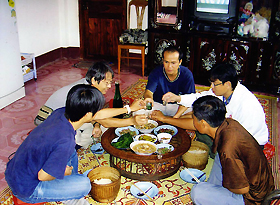(3) The latest field surveys were carried out in Vientiane, Bolikhamxay, Khammouane, Xiengkhouane, and HouaphaneProvince, in the periods April 17-27 and August 3-16, 2005, by accompanying Prof. KATO Makoto and Mr. KAWAKITA Atsushi from the Graduate School of Human and Environmental Studies, KyotoUniversity. This report focuses on the Houay Nyang protected forest, which is one of the few dipterocarp forests on the Vientiane plain. The Houay Nyang protected forest is located in Xaythany District, VientianeMunicipality, with an area of 808 ha. Although the area is too small to be designated as provincial or national protected forest under the current law, logging and the gathering of forest products have been prohibited in the area since before 1975,
the year of the revolution. However, the location is surrounded by villages and this seems to result in frequent illegal logging in the forest.
The surveys showed that the vegetation could be classified into two types; dry evergreen forest largely covered by small trees with sparse distribution of tall trees of Dipterocarpus alatus and Afzelia xyrocarpa, and dry dipterocarp forest where Dipterocarpus obtusifolius, Shorea obtusa, and Terminalia alata with a height of 5-10 m were dominant. Several important species were observed in the forest, such as Orophea sp. (Annonaceae), described as a rare species by "A Field Guide to Forest Trees of Northern Thailand," Brachycorythis helferi (Orchidaceae: Photo 1), and Pecteilis susannae (Orchidaceae: Photo 2).
Thus, it was revealed that the Houay Nyang protected forest harbored several important species despite its location in VientianeMunicipality. However, as is indicated by the physiognomy of the vegetation, the forest suffers from much human disturbance such as logging. In addition, it is said that a stadium and a golf course will be constructed around the forest in the near future. There is therefore an urgent need to conduct surveys on the flora and fauna in the Houay Nyang protected forest. We are also planning to conduct ethnobotanical studies in the surrounding villages.
(References)
Gardner, S., Sidisunthorn, P., and Anusarnsunthorn, V., A Field Guide to Forest Trees of Northern Thailand, Kobfai Publishing Project, Bangkok, 2000.
Vaddhanaphuti, N., A Field Guide to the Wild Orchids of Thailand, Silkworm Books, Chiang Mai, 2005.



 21st Century COE Program
-Aiming for COE of Integrated Area Studies-
21st Century COE Program
-Aiming for COE of Integrated Area Studies-